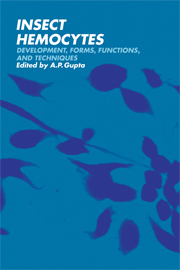Book contents
- Frontmatter
- Contents
- Preface
- List of contributors
- Part I Development and differentiation
- Part II Forms and structure
- Part III Functions
- 11 Hemocytes and growth in insects
- 12 Hemocytes and connective tissue: a critical assessment
- 13 Role of hemocytes in defense against biological agents
- 14 Cellular and humoral responses to toxic substances
- 15 Biochemical and ultrastructural aspects of synthesis, storage, and secretion in hemocytes
- 16 Changes in hemocyte populations
- Part IV Techniques
- Indexes
11 - Hemocytes and growth in insects
Published online by Cambridge University Press: 04 August 2010
- Frontmatter
- Contents
- Preface
- List of contributors
- Part I Development and differentiation
- Part II Forms and structure
- Part III Functions
- 11 Hemocytes and growth in insects
- 12 Hemocytes and connective tissue: a critical assessment
- 13 Role of hemocytes in defense against biological agents
- 14 Cellular and humoral responses to toxic substances
- 15 Biochemical and ultrastructural aspects of synthesis, storage, and secretion in hemocytes
- 16 Changes in hemocyte populations
- Part IV Techniques
- Indexes
Summary
Introduction
The purpose of this chapter is to review the contribution of the hemocytes to the processes, and particularly to the control, of insect growth and metamorphosis. But there are certain ancillary matters that must be briefly considered.
Hemocytes as a source of “embryonic cells”
Hemocytes arise as residual mesodermal cells at the conclusion of embryonic growth. Berlese (1900, 1901) regarded their differentiation to form muscles and other mesodermal tissues as being their main function during postembryonic growth in higher Diptera. Likewise, in Galerucella (Col.: Chrysomelidae), Poyarkoff (1910) included the imaginal myoblasts among the hemocytes. Nowadays, although embryonic cells (notably myoblasts, derived from imaginal histoblasts) may be moving freely in the hemocoel at certain stages in development, it is usual not to include them among the hemocytes (Crossley, 1964, 1975). However, Penzlin (1963), studying regeneration of limbs in Periplaneta, concluded that the new muscles are formed by blastema cells derived from the hemocytes, not from the epidermis. And there are many claims for fat body formation during postembryonic development from “mesodermal leucocytes” (see Wigglesworth, 1959, and Chapter 1).
Hemocyte types
There is a vast descriptive literature on the varied types of hemocytes in different groups of insects (Wigglesworth, 1959; Jones, 1962; Gupta, 1969; Crossley, 1975). In recent years the tendency has been to simplify these descriptions and to put the emphasis on a limited number of more or less well-defined types. It is hoped that this procedure will lead to the recognition of true homologies between blood cells of different insects, with the allocation of definite functions to common types of cells.
- Type
- Chapter
- Information
- Insect HemocytesDevelopment, Forms, Functions and Techniques, pp. 303 - 318Publisher: Cambridge University PressPrint publication year: 1979
- 13
- Cited by

